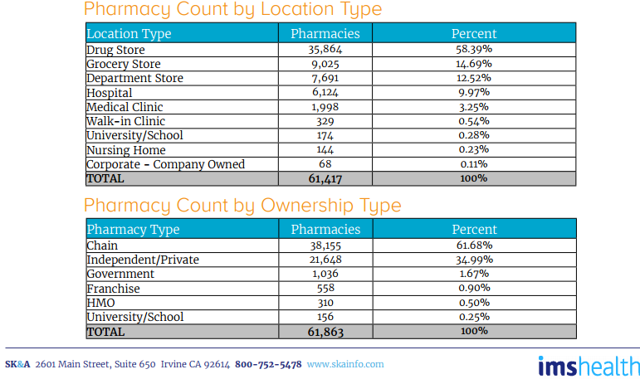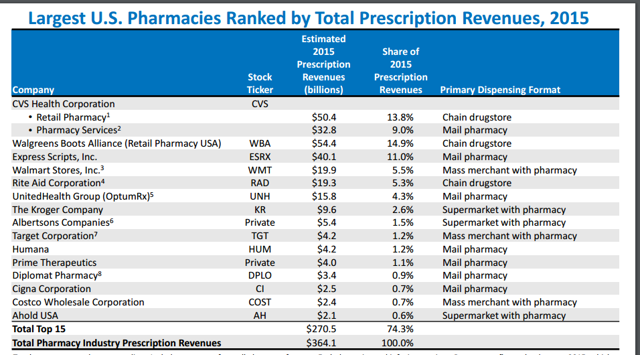If Rite Aid (NYSE:RAD)'s share price is any indication of the probability of FTC approval for the Walgreens-Rite Aid merger, it would be the least reliable indicator out there for any Rite Aid investor. Since their high last October following the announcement of Walgreens' $17.2 billion buyout, Rite Aid shares have fallen over 14%, even after a 6% rebound in the past month.
While this drop may be partly attributed to investors freeing up capital from a stagnant position to invest in a market that has seen record highs in recent days, I would be lying if I did not acknowledge the growing worry that antitrust regulators would clamp down on the deal.
However, claims that the FTC would block the merger are unfounded due to the competitiveness of the pharmacy market, the commitment that Walgreens has demonstrated to ensure the deal's approval and strong contrast between this merger and those axed by regulators.
Unlike The Staples-Office Depot Merger
The recently blocked $6.3 billion merger between Office Depot and Staples has wrongfully cast some doubt into the chances of government approval of Walgreens' acquisition.
Examining the merger purely based on market share, it is no surprise that the FTC intervened.
According to Reuters, last year, leading up to the proposed merger, Office Depot and Staples controlled a combined 69.2% of the office supply market, nearly double the estimated 35% of the chain drugstore market that Walgreens would control should the merger be approved.
Furthermore, antitrust regulators centralized their justification for preventing the acquisition on the fact that 79% of contract segment sales, or large, contracted business-to-business sales, in the office supply industry to Fortune 100 companies were accrued by either Staples or Office Depot, with both companies being each other's primary competitor shown in bidding data.
Upon the announcement of the Staples deal, some estimated that up to 1,000 stores, or more than a quarter of their combined store count, were to close in attempt to appease regulators, on top of the divestiture of $1.25 billion of commercial contracts that regulators ultimately rejected, suggesting the merger was bound to fail before it was even born.
In contrast to the Office Depot-Office Max merger in 2013 which merged two troubled companies into a single force capable of rivaling Staples on a retail and commercial front, an FTC-approved Staples-Office Depot merger would have given far too much pricing power to a office supply giant worth a combined $38 billion.
The inevitable failure of the Office Depot-Staples merger was not the result of an "aggressive" FTC, but the product of a contracting industry whose biggest players would have dominated an overwhelming majority of the bulk office supply market.
Post-Merger Pharmacy Market Will Remain Competitive
In contrast to the bulk office supply industry, the pharmacy market is already fragmented with a large number of competitors jostling for a share in growing prescription sales through various channels, such as retail drugstores, mail-order pharmacies, and pharmacy counters in supermarkets or big-box retailers.
Retail drugstores may be best characterized by chain stores such as Walgreens, CVS and Rite Aid, where prescription sales account for around two thirds of revenue at each firm.
Seeing as this is the primary source of revenue for Rite Aid and its competitors, the FTC will scrutinize this aspect of the merger most seeking to ultimately answer the question: Will a Rite Aid-Walgreens merger create an uncompetitive or unfair environment to consumers in the pharmacy and drug prescription market?
The short answer is no.
Disregarding the aforementioned market share numbers, the bottom line is that consumers will still have ample choice on where to fill prescriptions even if the merger goes through.
According to a study of the market produced by healthcare data provider IMS Health last year, only 58% of the 61,800 pharmacies in the United States exist as a brick-and-mortar drugstore, like Rite Aid and Walgreens, with much of the remaining 42% of competition pervading through grocery stores, department stores and hospitals.
In fact, nearly 35% of the pharmacy store count in the country exists as independent pharmacies, often pharmacist-owned, small businesses that dispense close to 40% of retail prescriptions and serve customers from America's smallest towns to its biggest cities.
Also, contrary to the popular belief that independent pharmacies are struggling in recent years, studies by IMS Health and NCPA Digest indicate that even amidst chain store pharmacy expansion and pharmacy benefit manager (PBM) consolidation, private pharmacy count remains stable with average prescription revenue even increasing.
Pharmacy chain stores also face strengthening competition from prescription-dispensing mass merchants and supermarkets including Kroger, Walmart, Safeway, Albertsons, Costco and Target's CVS-operated in store pharmacies.
Another 2015 study conducted by IMS Health also found that the number of prescriptions dispensed by such supermarkets and big box retailers collectively increased 6.1%, outpacing any other method of dispensing including through chain store pharmacies.
Walmart (NYSE:WMT)'s decade-old prescription segment, which accounts for much of this growth, is estimated to have generated nearly $20 billion in annual revenue last year, comparable to Rite Aid's $19.3 billion prescription revenue during the same period.
With a Walmart located only 15 minutes away from 90% of Americans and Walmart's competitive $4 monthly prescription generic drug program cruising to success, antitrust regulators will realize that the consumers will not be financially squeezed or left optionless by a Walgreens-Rite Aid merger.
Chain drugstores also face further pressure from mail-order prescription services through PBMs such as Express Scripts and United Healthcare's OptumRX which combine for a over 15% share in prescription revenues, a 24.9% increase in sales over the last two years.
Though this can partly be attributed to such specialty pharmacy PBMs mandating that scripts be distributed via mail-order services, some opine that as Millennials and Generation Xs enter the prescription drug market, there will be an uptick in the usage of online/mail-order pharmacy services, which can force major drugstore chains, particularly Walgreens, to slash prices or expand services to remain competitive.
Mounting competition from mail-order pharmacies, independent drugstores, and mass merchant pharmacy counters are relevant to the FTC's decision because they indicate that consumers have choice when fulfilling their prescription needs and whether they go online, down the street, or to a retailer or supermarket, they will not simply have to choose between CVS and Walgreens.
Let's Talk Store Divestiture
As with most mergers, the acquiring company will be forced to divest merged stores to a list of approved buyers in markets where the two companies compete in order to maintain competition.
Upon the announcement of the merger, Walgreens announced that it was willing to divest up to 1,000 of Rite Aid's 4,600 stores to appease regulators, yet the consensus and Walgreens itself estimate that they will have divest no more than 500 locations.
Based on analysis from Credit Suisse and the legal precedent established by the FTC in its approval of Rite Aid's Brook and Eckerd acquisition in 2007, it is likely that Walgreens would receive a consent order from the FTC requiring regional market share numbers of no higher than 50%, thus signaling government approval.
This would mean that Walgreens would have to divest 170 stores to reach a 50% market share threshold, 375 stores to be at a 45% threshold and 974 to be at a 40% market share, an unlikely number that would put the deal at risk.

After the Safeway-Albertsons merger divestiture embarrassment led to the ultra rapid expansion and subsequent bankruptcy of Haggens last year, it is safe to assume that the FTC will require a large number of divested Rite Aid stores to be acquired by CVS, whose 9,600 locations could easily absorb at most a 7% store count expansion.
Specifically, CVS will be looking to the merger as an opportunity to add on to their 30 recently opened drugstores in the Pacific Northwest to increase pressure on regional drugstore chain, Bartell's, while other local chains across the United States could play their hands in some divested locations.
It is important to note that these numbers simply measure brick and mortar drugstore count and fail to account for prescription dispensing through channels such as mail-in pharmacy, which the FTC should concede can gain traction in the next few years, as previously mentioned.
With this in mind, it is hard to see the FTC requiring Walgreens to sell off more than 500 stores, though we could see some closures conducted by Walgreens to avoid cannibalization due to geographical overlap of two storefronts, as there are over 20% of Walgreens with at least one Rite Aid within 1 mile.
Though a number of deals squashed by the FTC recently may have shaken arbitrage investors, I am sure that the Rite Aid-Walgreens merger will be approved because in the expanding prescription drug market, there exists sufficient channels and competition for consumers to ensure lower prices.
Clues Have Only Been Positive
While it has been almost ten months since the announcement of the merger in October, it should not be a surprise that the FTC has not reached a verdict yet.
Both companies stated at the inception of the merger that approval will not be official until sometime in the second half of 2016, yet we are not even two months into that period.
With a deal topping $17 billion in valuation, there is much analysis to be done and the agency would not risk a bad image in releasing approval too early.
Another factor into the decision is Walgreens recent decision to not pursue a $4 billion tax inversion following their merger with European pharmacy chain, Alliance Boots, which could lead the FTC to have a more favorable view of Walgreens in approving the Rite Aid acquisition.
Furthermore, Walgreens CEO Stefano Pessina even noted in a conference call last month that there have been no negative signals from the FTC and that "By December, everything should be done."
Newly released data also indicate that notable hedge fund managers, such as David Einhorn and Mario Gabelli, among others, have been buying up Rite Aid in an effort to capitalize on a great net arbitrage spread, endorsing the chance of FTC approval.
Accounting these factors and the competition in the drugstore market, the FTC will approve the deal, thus providing a very healthy return for any low-risk, logical investor buying today enticed by the 21% return on investment.
